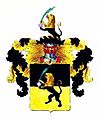Wedemeyer (noble family)
The von Wedemeyer family (also spelled Wedemeier , Wiedemayer ) is a Lower Saxony state civil servant and patrician dynasty that has acquired manors since the 16th century and received the post office in 1819 .
history

The family traces its origin back to Hans Wedemeyer (1336–1419). In the 15th and 16th centuries, members rose to high state officials of the Dukes of Braunschweig and Lüneburg . Konrad Wedemeyer the Elder (1533–1598), son of a mayor of Gronau , rose as a lawyer to the Princely Councilor and Grand Voyage . In 1564 Duke Erich II enfeoffed the Eldagsen estate . The Wedemeyer resident there have been members of the Calenberg knighthood since 1576 .
After Eldagsen Castle was destroyed in the Thirty Years' War, the brothers Dietrich (1611–1683) and Werner Wedemeyer shared ownership and founded the two families of "Obergut" and "Untergut"; both are still owned by the family today.
Obergut Eldagsen (Lower Saxony)
Werner's son Conrad Werner Wedemeyer (1662–1732) was the Braunschweig-Lüneburg Oberamtmann in Lauenstein . In addition to his parents' farm in Eldagsen, he acquired a number of goods in Thuringia, which he sold again in later years.
In Hanover , the Wedemeyer were traditionally one of the so-called “ Pretty Families ”, a kind of bourgeois “state patriciate ”.
Johann Franz Justus Wedemeyer, farmer on Untergut Eldagsen, bought the Anrode monastery in Thuringia in 1811 , which remained in the family until 1886. His son August Wilhelm Wedemeyer was ennobled in Prussia in 1819. His son Georg Ludwig von Wedemeyer (1781–1867), lawyer and farmer on Untergut Eldagsen, was a member of the Frankfurt National Assembly in 1848/49 . He temporarily owned the Langhagen estate in Mecklenburg-Schwerin (1815 to 1846) and in 1836 he also acquired the Schönrade estate in the then Brandenburg district of Friedeberg Nm. , which became the headquarters of the Untergut Line. His son Ludwig von Wedemeyer (1819–1875), also a lawyer and farmer on Schönrade, Anrode and Eldagsen, was an opponent of Bismarck as a member of the Reichstag of the North German Confederation . In 1864 he also acquired the Woynitz estate in the Schmiegel district and in 1874 the Hohen Wartenberg estate in the Königsberg Nm district.
The Pätzig manor near Königsberg in the Neumark was owned by Hans von Wedemeyer , who, as the office manager of Reich Chancellor Franz von Papen , spoke out against the appointment of Hitler as Reich Chancellor in 1932/33. He was active in the Berneuchen movement and his daughter Maria von Wedemeyer got engaged in 1943 to the theologian Dietrich Bonhoeffer , who was executed as a resistance fighter in 1945.
The Mecklenburg Gut Langhagen is now again owned by the von Wedemeyer family (Untergut Eldagsen).
Klostergut Anrode (Thuringia)
Schönrade Palace (Neumark)
Woynitz (formerly Posen Province)
Hohen Wartenberg (Neumark)
coat of arms
Blazon : The shield is divided by black and gold, on it a lion in mistaken tinctures, which holds a green palm frond in the upper paw and the lower a silver hexagonal star. The helmet is shown crowned or bulged , with the lion growing on it. The ceilings are black and gold.
Coat of arms in Grotes gender book
Personalities

- Konrad Wedemeyer the Elder (1533–1598), Grand Bailiff of the Principality of Calenberg
- Conrad Werner Wedemeyer (1662–1732), senior bailiff
- Johann Carl Conrad Wedemeyer (1750–1812), bailiff at Westerhof
- Georg Ludwig von Wedemeyer (1781–1867), member of the Frankfurt National Assembly
- Ludwig von Wedemeyer (1819–1875), lawyer, manor owner and politician
- Hans von Wedemeyer (1888–1942), German lieutenant colonel d. Res. And large landowners
- Conrad von Wedemeyer (1870–1947), district administrator
- Maria von Wedemeyer (1924–1977), fiancee of the evangelical theologian and resistance fighter against National Socialism Dietrich Bonhoeffer
- Hans Werner von Wedemeyer (1927–2020), businessman and peace activist, brother of Maria von Wedemeyer
literature
- Chronica Wedemeyeriana. Copy with additions and some translations, completed in early 1989 , undated, undated
Web links
Individual evidence
- ^ Dirk Henning Hofer: Karl Konrad Werner Wedemeyer (1870-1934). A legal and scholarly life in three realms. A biography (= legal history series , vol. 399), also a dissertation in 2009 at the University of Kiel, Frankfurt, M .; Berlin; Bern; Bruxelles; New York, NY; Oxford; Vienna: Lang, 2010, ISBN 978-3-631-59422-3 , p. 29; online through google books








